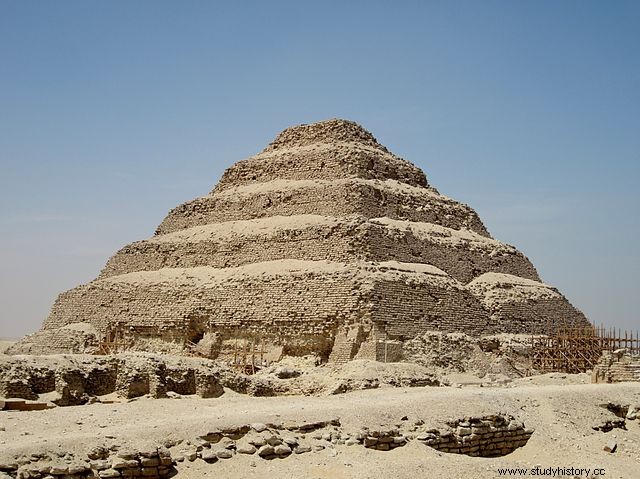Photo credit:©Olaf Tausch, 2009
Djoser reigns over Egypt around -2650, under the III th dynasty of the Old Kingdom, of which he is the second king. Under his authority, the country is unified. The necropolis of Saqqara, not far from Memphis, has always housed the tombs of kings. They are erected outside the city, on the edge of the desert, on a plateau to avoid flooding and especially where the sun sets, symbol of the ending reign. Kings are buried in mastabas (Egyptian funerary buildings), as are nobles.
Around 2650 BC

Characters
Djoser
Imhotep
Procedure
The mastabas were made of bricks and some stones. But the grand vizier of Djoser, Imhotep, a doctor and astronomer best known for his talents as an architect, decided to create a new mortuary monument. Indeed, the pyramid he created is the first monument in the world to be built entirely of cut stone (stone with all sides cut). In addition, Imhotep initiates the difference in size between the tomb of the pharaoh and ordinary mortals, thereby emphasizing the importance of the ruler. If the base of the pyramid was square at first, it then becomes rectangle then, Imhotep adds 4 degrees.
If these differences show the hesitations, they also betray a need for perfectibility to satisfy the pharaoh and himself. From the outside, it looks like 6 stacked mastabas, but the architect tilted them to stabilize the structure and allow it to be erected and reach 62 meters high, with a base of 109 x 121 meters. If the mastabas of that time were like the homes of the living, Imhotep invites religion into the architecture and physically symbolizes the rise of the pharaoh's spirit to the heavens. Indeed, these degrees are also similar to staircases so that the soul can leave Hades for heaven, and, conversely, that the gods can thus descend to earth. Unlike the mastabas which were a single funerary monument, the pyramid is located in the center of a complex, around which there are 4 interconnected galleries, 3 inner courtyards, temples, the serdab (cellar where the statue of Djoser was ), the north and south house, etc. A wall encloses this immense space (15 ha) and if many doors are artificial, only one gives access to the sanctuary. The two stelae at the entrance are decorated with a lotus for one and a papyrus for the other. Symbols of Upper and Lower Egypt, this step pyramid underlines, through these representations, how much Djoser is the king of unified Egypt.
Consequences
This step pyramid of Saqqara is the first pyramid in the world. She will be emulated by her successors, definitively changing the Egyptian landscape. This monument indeed foreshadows the famous pyramids of Giza. It is a fundamental marker differentiating the pharaohs and ordinary mortals. In addition, this pyramid embodies eternity. Also, the desire to build it in stone is not insignificant. Its material is rot-proof (which cannot putrefy) and there is no doubt that other civilizations, Greek, Roman, etc., will use it.
